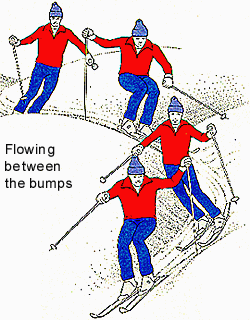 Ski Tips & Ski Instructions
Ski Tips & Ski Instructions
These Ski Tips are not a substitute for hands-on ski instruction and practice. They are intended as brief reminders of the key components in Ski Easy clinics – having fun in a safe and efficient manner.
Have fun and remember – Ski Easy!
Ski Tips
1. Use the appropriate equipment for your skiing ability and the snow conditions. For most people this means using soft boots (not stiff and not race) that are not too big; skis that have a medium radius sidecut (15 m to 22 m radius); skis with a waist of around 75 mm to 80 mm; neither too short nor too long skis (between shoulder and head depending on ability). Allround skis typically fit this category.
2. Before putting skis on, check that your boots flex properly. This means flexing forward and checking that your ankle bends in the boot. If it does not, then you may need to adjust or change your boots.
3. With boots on, but without skis, jump up and down from the ankles. If you cannot do this, practise until you can – remember to flex the ankle joint and jump up and down with minimum movement in the other joints of the body.
4. Remind yourself of the FIS safety code before putting your skis on.
5. Repeat exercise 3. with skis on.
6. Repeat exercise 5. while skiing and making turns on gentle terrain.
7. Stand tall! Most people bend over at the waist which causes the muscles to tense up, removing the required flexibility – racers can do this, but recreational skiers are better off standing up. Bending over also puts the weight behind the centre of the skis, making them more difficult to turn. If you ever have a burning or tired sensation in your thigh muscles (quadriceps) then you are skiing with your weight back and need to stand up more to bring yourself into the middle of the skis. Ski Easy skiers can ski all day and not have tired quads at the end of the day!
8. Practise side-slipping. Do this straight down the fall-line; slipping forward; slipping backwards. Remember to do this on both sides and to practise more on your weaker side – we all have one!
9. Ski in a traverse in a steeper slope and finish with a (fast) side-slip without changing direction. This is a critical safety exercise and will enable you to control your skis in any situation.
10. Ski in a steeper traverse angle (i.e. more down the fall-line) and finish with a hockey-stop. This is another critical exercise for safe skiing.
11. Initiate turns with the new inside foot. This is key in smooth parallel skiing. Remember the trigger phrase “little toe to the snow”. Left toe to go left, right toe to go right – Easy!
12. Look where you want to go! This means keeping your chin up – think of having a cocktail stick propped up from the front of your collar to the bottom of your chin – if you lower your head to look down, then it will hurt! (Health and Safety Notice – we are not saying to actually use a cocktail stick, it is only an analogy to help you!) Many people ski looking down at the ski tips of them – this is like driving your car looking at the accelerator pedal – no-one would do this, so why do it when you are skiing!
13. Control your speed with turn shape, not with sudden jerky movements. This means if you are carving, then let the skis carve uphill before starting the next turn. This needs lots of room, so only carve when the slopes are wide-open, with good pisting and with few or no other people around. For most people it is better to use parallel turns on a soft or feathered edge and still turn the skis uphill at the end of the turn. This type of turn can help you to ski bumps, soft snow, powder and crud.
14. Vary the amount of edge you use according to the conditions. When in doubt, use less edge rather than more. Most skiers have too high an edge angle and consequently often lose control or go too fast as well as getting tired.
15. Ski from the feet up. If you stand tall in the middle of the skis, then excess body movements tend to go away. This promotes relaxed skiing, where your skis follow the terrain and effort is minimised.
16. No Smoking! This doesn’t mean no cigarettes or cigars, it means that the end of one turn forms the beginning of the next. Many skiers have a flat-spot between turns, like taking a puff from a cigarette! Smooth skiing means no matter the radius of the turn, go directly from the end of one turn into the next. This is one of the Ski Easy fundamentals and Ski Tips that makes Ski Easy skiers look so elegant – their style is a product of good technique, not of trying to look good!
There is one problem with Ski Easy, however. You will be smiling so much that your teeth will hurt!
On the hill, just remember these key pointers. Stand tall. Look where you want to go. Little toe to the snow. Soft edges Flow from one turn into the next.